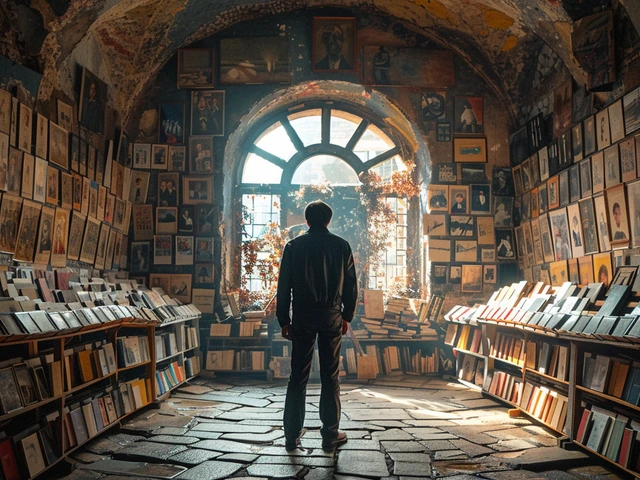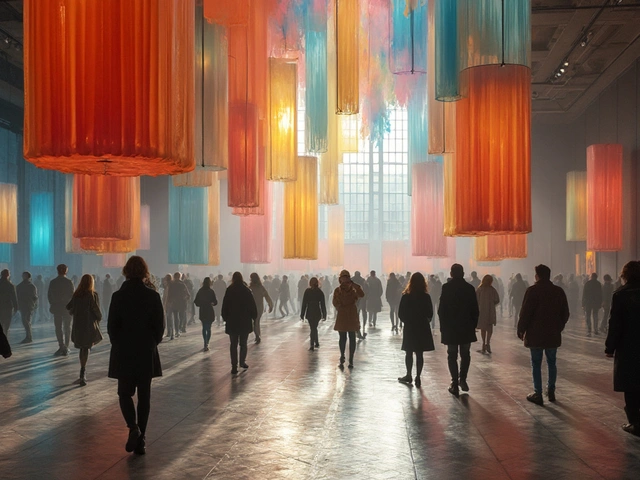What on Earth is Magical Realism?
Imagine this: you're walking down a path that seems simple enough, grounded in the tangible world, when suddenly a whirlwind of color bursts from the ground, and a flock of parrots, speaking fluent French, sweeps past you. The man next to you, unfazed, continues to sip his tea as if parrots chat about Proust every day. Welcome to the wonderfully weird and whimsical world of magical realism. This genre, my dear readers, is a beguiling blend of the ordinary and the fantastical, in which the supernatural is presented as mundane, and the mundane as supernatural.
So, it's like a guessing game of what will happen next! Just when you think you've got the plot pegged as your common garden-variety narrative, a character might float away with the balloons from a child's birthday party, or a ghost might show up for dinner and critique the wine selection. My first encounter with Magical Realism was a bit like my daughter, Maeve, deciding that our greyhound, Jasper, could talk. As silly as that sounds, in the hands of a magical realism maestro, you find yourself nodding along to Jasper's treatise on squirrels. That's the power—and delight—of this transcendent genre.
Spellbinding Stories: A History of Magical Realism
Though now we often associate magical realism with the Latin American literary boom, its roots are as international as the United Nations of the imagination. It's a bit like tracing my family's genealogy, which spans from the Highlands of Scotland to the busy streets of Sydney—unexpected, diverse, and full of surprises. The term "magical realism" was first coined by German art critic Franz Roh in 1925 to describe art that depicted the real world imbued with mysterious elements. Fast forward a couple of decades and writers from South America took this concept and ran with it, high-fiving each other in a glorious relay of creativity.
The literary trend bloomed like my neighbor's unnaturally vibrant petunias, with the works of Gabriel García Márquez and Isabel Allende often held up as exemplars. These stories were engaging, with layers of meaning woven through them as intricately as the plot of Maeve's latest school play (where I swear the trees in the background moved when nobody was looking). They portrayed political and social commentary in a way that was neither dry nor preachy, but mesmerizing, like being hypnotized by the glittering eyes of a talking jaguar who dissects Marxist theory. It was revolution by way of whimsy and wonder, and who can resist that?
Defying Definition: The Elements of Magical Realism
Alright, so what exactly are the building blocks that make up the fairy tale castle of magical realism? It's not all sleeping dragons and cackling witches; no, this genre works best when it's grounded in reality. It's like baking a cake with celery—it shouldn't work, but somehow it does, creating something deliciously unexpected. One key element is the real-world setting. The stories unfold in our familiar, tangible world, not a far-off kingdom or parallel universe. It's the Sydney Opera House, with a mermaid doing vocal warm-ups backstage—delightfully unexpected!
Next up, we have the fantastical elements, which are treated with the nonchalance of discussing the weather. A character may wake up with angel wings but faces more concern about how to fit through the front door than existential questioning of their divinity. One day on our morning walk, Jasper might solemnly advise me on my investment portfolio, and we'd just carry on sniffing hydrangeas. Then there's the distortion of time. Time might swirl and loop like soft-serve ice cream, leaving readers with a bit of brain-freeze as past, present, and future coalesce. It’s not unlike trying to keep track of a group of kids after a sugar-fueled birthday bash—everywhere and chaotic, but part of the fun.
The Maestros of Magic: Iconic Artists of Magical Realism
When it comes to the virtuosos of magical realism, certain names echo through the halls of literary fame like a spell being cast. Gabriel García Márquez, with "One Hundred Years of Solitude," crafted a town so alive with enchantment and heritage, it felt like a character itself. It was the kind of book that made me look twice at passersby, half-expecting them to transform into butterflies or vanish in a puff of smoke.
Then we have Isabel Allende, whose "The House of the Spirits" wove together the lives of the Trueba family with the ease of a grandmother knitting socks, sprinkling the narrative with prophecies and telekinesis as casually as adding pepper to soup. Salman Rushdie, with his "Midnight’s Children," blended the real with the mythic so masterfully, it felt like he was playing chess with reality itself. I still check my spice cabinet half-expecting to find a genie nestled between the cinnamon and turmeric. Such is the lasting impression of these master storytellers.
Magical Realism in Pop Culture
Think magical realism is confined to dusty old bookshelves or the hushed halls of academia? Think again! It has leapt from the pages and onto the screen, infiltrating movies and television like a mischievous sprite. Take "Pan's Labyrinth" by the visionary director Guillermo del Toro—the horrors of war are interspersed with encounters with creatures that belong more in dreams than in the brutal reality of 1940s Spain. If a faun started giving me quests during my weekly grocery run, you can bet I’d take a gander at what magical items were on sale.
Or there's "Midnight in Paris," a film that dances with time as gracefully as a ballerina en pointe, whisking its protagonist to soirees with literary legends of the past as easily as if he'd stepped into a cab rather than a time warp. And, of course, we can't forget about the streaming series that sprinkle magical realism like fairy dust across their storylines, enthralling audiences who might otherwise never dive into a Marquez novel. They lure you in with their charm until, bam, you're considering if your cactus might have secret desires or your toaster has ambitions beyond browning bread.
Writing with Whimsy: Crafting Your Magical Realism Story
So, you want to try your hand at penning a story where the extraordinary and ordinary have a tea party? The key is balance. Remember, you're not writing a fantasy epic or a sci-fi saga. This is like macrame—it's art, it's function, and somehow it manages to be both without compromising on either. Begin with a character or a setting that's grounded in the real world. Then, apply the same logic to the magical as you would if you were describing breakfast. It's not about the spectacle; it's about the integration. Imagine if I told Maeve that yes, she has a unicorn, but it prefers eating toast over rainbows—that's the essence you're aiming for.
Let your characters accept the strange goings-on as part of their everyday existence. The neighbors might have a zombie living with them, but as long as he mows the lawn on Sundays, who cares if he’s a bit decomposed? The heart of magical realism lies in its ability to make the implausible plausible, the mundane mesmerizing. Through symbolism and allegory, these stories can reflect the complexities of life, society, and the human condition in a way that's as enchanting as it is thought-provoking. So go on, throw in that fortune-telling goldfish or rain that whispers old lullabies. Let your imagination tango with reality, and who knows—your story might just be the next one to redefine boundaries.
Living a Magical Realist Life
What if we looked at our world with the lens of magical realism? It would be a place where every thunderstorm is a drum solo by the gods, where lost socks are actually on secret missions to reunite with their sock-spouse, trekking through the murky underbelly of your laundry basket. It's about finding the magic in the mundane, the extraordinary in the ordinary. As I tackle the mountain of dishes post-Maeve's lasagna experiment (that kind of mess truly requires a wizard's intervention), I imagine a world of tiny dish-fairies that take to the skies on their sponges.
The beauty of magical realism is that it encourages us to view life’s quirks with wonder and to embrace the possibility of the impossible. It offers a respite from the rigors of reality, a little slice of the fantastical to carry with us in our pockets. It’s a reminder that life can be as magical as the stories we read or write, if only we choose to see it that way. And so, while Jasper hasn't yet offered me stock market advice, I look at his soulful eyes and think, "Well, why couldn't he, if this were a tale of magical realism?" So, let’s embrace the extraordinary, sprinkle a little magic into our days, and who knows? Perhaps one day, the extraordinary will embrace us back.




